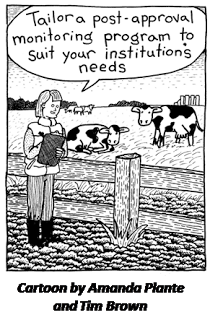 by Amanda Plante, PRIM&R Blog Squad Member
by Amanda Plante, PRIM&R Blog Squad Member
PRIM&R is pleased to bring you the final live post from the 2011 IACUC Conference and the PRIM&R Blog Squad. The Blog Squad is composed of members who are devoted to blogging prior to, live from and after the PRIM&R’s conferences.
Hello again! On Thursday I participated in a moderated poster abstract discussion and presented my poster titled, “Post-Approval Monitoring Programs Across Canada – Building on Strengths and Facing Challenges.” If you are interested in receiving a copy of my poster, please feel free to e-mail me. As a Canadian, I am constantly seeking to learn more about US animal care and use policies. As such, I thought you might find insights on post-approval monitoring (PAM) from the Great White North to be of interest.
Canadian standards for experimental animal care and use are regulated by the Canadian Council on Animal Care (CCAC). Institutional compliance is monitored through the CCAC assessment program (similar in its use of peer review assessments to the AAALAC International accreditation program). The CCAC program is based on scientific peer review, policy making, and responsibility at the institutional level. During a CCAC assessment visit, the CCAC evaluates how the PAM program is working and how effective it is in ensuring that protocols and standard operating procedures (SOPs) are applied by the animal care committee (ACC).
The CCAC Policy Statement on Terms of Reference for Animal Care Committees (section 2) has required that: “Each institution must establish procedures for PAM of animal use protocols, and must define the roles and responsibilities of the members of the animal care and use program in the monitoring process.”
The CCAC Policy Statement for Senior Administrators Responsible for Animal Care and Use Programs also outlines PAM requirements. The CCAC does not prescribe what a PAM program should look like, but encourages a program to be based on best practices and focused on institutions’ needs.
The Natural Sciences and Engineering Research Council of Canada is one of the three major federal funding agencies that comprise the Tri-Council. In order to receive funding from the Tri-Council, universities must sign a memorandum of understanding (MOU). Schedule 3 of the MOU specifically covers the ethical review of research involving animals. One requirement is: “The institutions must have procedures in place to monitor ongoing work and to ensure conformity with federal and provincial guidelines, regulations, and laws covering the use of animals in research, teaching and testing.”
Many Canadian institutions have recently begun to develop and implement PAM programs. In order to learn about common issues and best practices, the research ethics office at the University of Saskatchewan conducted a survey of Canadian institutions with PAM programs. The survey was distributed via a PAM coordinators listserv.
Fifteen institutions responded to the survey, which offered key findings such as:
- Most institutions have designated personnel to coordinate PAM programs
- PAM programs are generally conducted by animal health technicians and/or veterinarians
- The CCAC category of invasiveness (CofI) determines which animal use protocols are selected for a PAM visit, as well as the frequency of visits
- CofI level D and E protocols are given highest priority
- Protocols were selected randomly or for cause
- The animal care committee is at the center of PAM with reports from the PAM visits being reviewed by the ACC
The main challenges faced by Canadian institutions in developing PAM programs include:
- Lack of support from senior administration/institutional official (IO)
- Lack of education on the need for, and importance of, PAM
- Lack of financial and human resources
- Workload and time limitations
- Scheduling PAM with team and principal investigator
- Communication with internal units (e.g. biosafety)
- PAM for field studies
- Bridging jurisdictional issues; collaborative projects
- Achieving set targets for review
Best practices for PAM identified by the institutions include:
- Good communication between researchers, the ACC and the PAM panel
- Partnership approach; collaborative to facilitate research and compliance
- A flexible, adaptive PAM program
- Online electronic protocol review system
- Efficiently functioning ACC with ‘open door’ policy
- PAM program is well received by researchers and open to collegial visits
- SOP databank assists researchers and helps PAM identify deviations
- Integration of PAM training and opportunity for knowledge transfer
As noted at a workshop on Post-Approval Monitoring: Formal and Informal Approaches, there are a variety of ways in which PAM can be incorporated into an animal care and use program, including formalized audits, lab surveys, reviews and facility inspections, reviews of protocols, adverse event reporting, veterinary rounds, animal care staff reporting to facility managers, casual lab visits, veterinary follow-up to morbidity and mortality reports, consultations, and pre-reviews.
For the success of any PAM program, it is vital to embrace a collaborative approach, one that facilitates and maintains a collegial environment where the health, welfare, and care of animals is given highest priority while still ensuring excellence in research and teaching.

No comments! Be the first commenter?